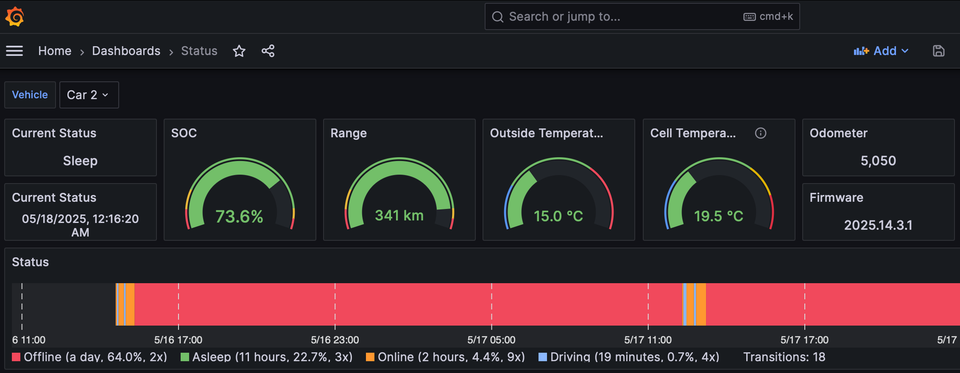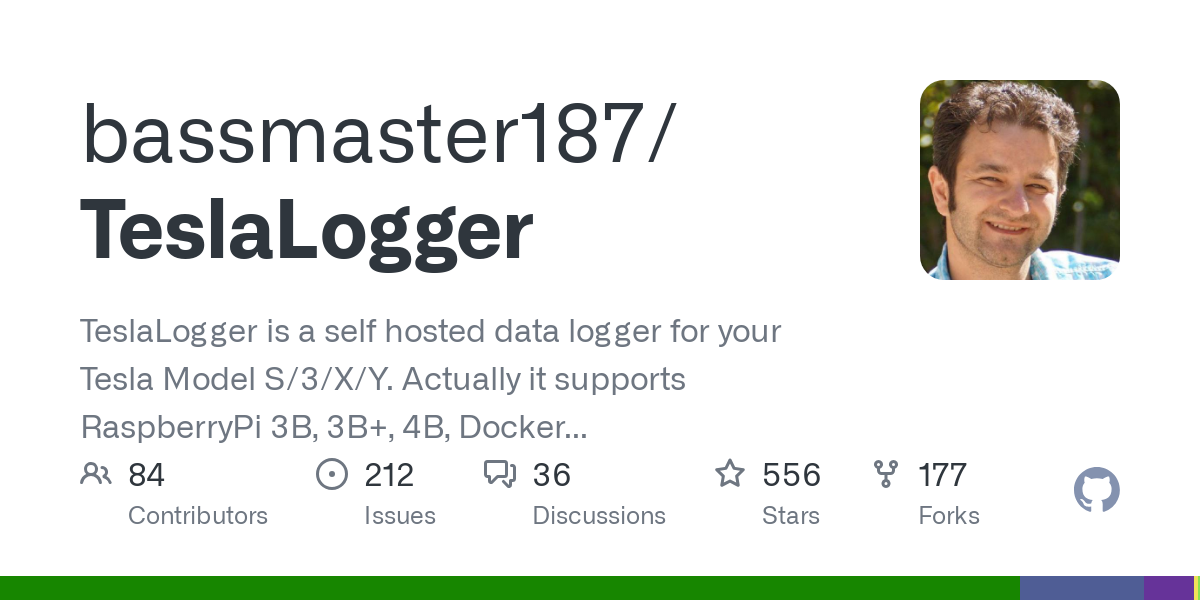Setting up TeslaLogger with a self-hosted Telemetry Server

This post expands in a bit more detail setting up TeslaLogger with a Local / self-hosted Tesla fleet telemetry server as outlined here:
TeslaLogger/TeslaLogger/LocalTelemetry.md at master · bassmaster187/TeslaLogger
TeslaLogger is a self hosted data logger for your Tesla Model S/3/X/Y. Actually it supports RaspberryPi 3B, 3B+, 4B, Docker and Synology NAS. - bassmaster187/TeslaLogger

If you don't need a writeup, here's the docker compose and configs for the stack:
services:
fleet-telemetry:
image: tesla/fleet-telemetry:latest
command:
- /fleet-telemetry
- -config=/etc/fleet-telemetry/config.json
ports:
- 12345:12345
- 5284:5284
volumes:
- ./config.json:/etc/fleet-telemetry/config.json:ro
- ./certbot/conf/live/yourtelemetry.domainname.com/fullchain.pem:/certs/fullchain.pem:ro
- ./certbot/conf/live/yourtelemetry.domainname.com/privkey.pem:/certs/privkey.pem:ro
tesla_http_proxy:
image: tesla/vehicle-command:latest
ports:
- 4443:4443
environment:
- TESLA_HTTP_PROXY_TLS_CERT=/config/tls-cert.pem
- TESLA_HTTP_PROXY_TLS_KEY=/config/tls-key.pem
- TESLA_HTTP_PROXY_HOST=0.0.0.0
- TESLA_HTTP_PROXY_PORT=4443
- TESLA_HTTP_PROXY_TIMEOUT=10s
- TESLA_KEY_FILE=/config/fleet-key.pem
- TESLA_VERBOSE=true
volumes:
- ./certbot/conf/live/yourtelemetry.domainname.com/fullchain.pem:/config/tls-cert.pem:ro
- ./certbot/conf/live/yourtelemetry.domainname.com/privkey.pem:/config/tls-key.pem:ro
- ./certs/private-key.pem:/config/fleet-key.pem:ro
certbot:
image: certbot/dns-cloudflare:latest
volumes:
- ./certbot/lib/:/var/lib/letsencrypt/:rw
- ./certbot/conf/:/etc/letsencrypt/:rw
command: certonly --non-interactive --agree-tos --dns-cloudflare
--dns-cloudflare-credentials /etc/letsencrypt/cloudflare.ini -d
yourtelemetry.domainname.com
web:
# This needs to be set up with SSL. Either configure it w/ the same LE certificate from above, or put this behind Cloudflare / reverse proxy that provisions automatically.
image: nginx
volumes:
- ./html:/usr/share/nginx/html:ro
ports:
- "80:80"
environment:
- NGINX_HOST=yourtelemetry.domainname.com
- NGINX_PORT=80
restart: unless-stoppedfleet-telemetry/compose.yaml
{
"host": "",
"port": 12345,
"log_level": "debug",
"json_log_enable": true,
"namespace": "TeslaLogger",
"reliable_ack": true,
"transmit_decoded_records": true,
"logger": {
"verbose": true
},
"zmq": {
"addr": "tcp://*:5284",
"verbose": true
},
"records": {
"alerts": [
"zmq"
],
"errors": [
"zmq"
],
"V": [
"zmq"
]
},
"tls": {
"server_cert": "/certs/fullchain.pem",
"server_key": "/certs/privkey.pem"
}
}
fleet-telemetry/config.json
<?xml version="1.0" encoding="utf-8"?>
<configuration>
...
<applicationSettings>
<TeslaLogger.ApplicationSettings>
...
<setting name="TelemetryServerURL" serializeAs="String">
<value>tcp://192.168.xxx.xxx:5284</value>
</setting>
<setting name="UseTelemetryServer" serializeAs="String">
<value>True</value>
</setting>
<setting name="TelemetryServerType" serializeAs="String">
<value>ZMQ</value>
</setting>
<setting name="TeslaHttpProxyURL" serializeAs="String">
<value>https://yourtelemetry.domainname.com:4443</value>
</setting>
<setting name="TelemetryClientID" serializeAs="String">
<value>YOUR_TESLA_APPLICATION_CLIENT_ID</value>
</setting>
</TeslaLogger.ApplicationSettings>
</applicationSettings>
...
</configuration>
teslalogger/TeslaLogger/bin/TeslaLogger.exe.config
^ If this file doesn't exist, copy teslalogger/TeslaLogger/App.config as teslalogger/TeslaLogger/bin/TeslaLogger.exe.config and make the changes above.
Tesla Setup
Pre-requisites
- You need to have an FQDN and DNS record that points to the IP you're hosting this on. You also need to port forward ports:
12345,4443.
Notes
- When creating a developer application, set the origin URL as the same domain you used in the docker compose. (eg: yourtelemetry.domainname.com)
- For redirect URL, you can set it to whatever you want. It really doesn't matter as long as you keep it consistent (eg: localhost)
Make a note of your: client_id, redirect_uri, VIN
Steps
- Complete step 1-8 from https://github.com/teslamotors/fleet-telemetry?tab=readme-ov-file#configuring-and-running-the-service
- Get your tokens and authorize your app.
https://fleet-auth.prd.vn.cloud.tesla.com/oauth2/v3/authorize?&client_id={client_id}&locale=en-US&prompt=login&redirect_uri={redirect_uri}&response_type=code&scope=openid vehicle_device_data offline_access&state=$STATE- After you authenticate, you will be redirected to
https://{redirect_uri}/?locale=en-US&code=NA_xxxxx&state=%24STATE&issuer=https%3A%2F%2Ffleet-auth.tesla.com%2Foauth2%2Fv3 - Write down the token in the
codeparameter. (NA_xxxxxxxx)
- Now you can get your access token!
CODE=NA_xxx
CLIENT_ID=YOUR_APP_CLIENT_ID
CLIENT_SECRET=YOUR_APP_CLIENT_SECRET
AUDIENCE=https://fleet-api.prd.na.vn.cloud.tesla.com
CALLBACK=YOUR_REDIRECT_URI
curl --request POST \
--header 'Content-Type: application/x-www-form-urlencoded' \
--data-urlencode 'grant_type=authorization_code' \
--data-urlencode "client_id=$CLIENT_ID" \
--data-urlencode "client_secret=$CLIENT_SECRET" \
--data-urlencode "code=$CODE" \
--data-urlencode "audience=$AUDIENCE" \
--data-urlencode "redirect_uri=$CALLBACK" \
'https://fleet-auth.prd.vn.cloud.tesla.com/oauth2/v3/token'- This will return something like:
{"access_token":"eyJhbGciOiJSUxxx","refresh_token":"NA_xxx","id_token":"eyJhbGciOxxx","expires_in":28800,"state":"$STATE","token_type":"Bearer"}% - Keep track of the access_token and your refresh_token.
- Pair the Virtual key:
- On your phone with the Tesla app installed, go to this URL (replace placeholder with your FQDN):
https://tesla.com/_ak/yourtelemetry.domainname.com
- On your phone with the Tesla app installed, go to this URL (replace placeholder with your FQDN):
- Configure fleet telemetry (this is what instructs Tesla's API to stream data to your telemetry-server. Note the curl URL is to your command_proxy):
- export TESLA_AUTH_TOKEN=your_access_token
- For the "ca" field, you can get the certificate authority certificate by running
openssl s_client -showcerts -connect yourtelemetry.domainname.com:12345- The string you're looking for is just under
1 s:C=US, O=Let's Encrypt, CN=E5...--—BEGIN CERTIFICATE--—. REMOVE all line breaks and insert it to the code snippet below at CERTIFICATE_DATA_HERE.
curl -H "Authorization: Bearer $TESLA_AUTH_TOKEN" \
-H 'Content-Type: application/json' \
--data '{
"vins": ["YOUR_CAR_VIN"],
"config": {
"hostname": "yourtelemetry.domainname.com",
"port": 12345,
"ca": "-----BEGIN CERTIFICATE-----\nCERTIFICATE_DATA_HERE\n-----END CERTIFICATE-----\n",
"fields": {
"PackVoltage": { "interval_seconds": 10 },
"PackCurrent": { "interval_seconds": 10 },
"ACChargingPower": { "interval_seconds": 10 },
"ACChargingEnergyIn" : { "interval_seconds": 60 },
"DCChargingPower": { "interval_seconds": 1 },
"DCChargingEnergyIn" : { "interval_seconds": 30 },
"ChargeLimitSoc": { "interval_seconds": 30 },
"FastChargerPresent": { "interval_seconds": 5 },
"Location": { "interval_seconds": 1 },
"VehicleSpeed": { "interval_seconds": 1 },
"Gear": { "interval_seconds": 5 },
"EstBatteryRange": { "interval_seconds": 30 },
"RatedRange": { "interval_seconds": 30 },
"IdealBatteryRange": { "interval_seconds": 30 },
"Soc": { "interval_seconds": 15 },
"ModuleTempMax": { "interval_seconds": 60 },
"NumModuleTempMax": { "interval_seconds": 60 },
"ModuleTempMin": { "interval_seconds": 60 },
"NumModuleTempMin": { "interval_seconds": 60 },
"NumBrickVoltageMax": { "interval_seconds": 60 },
"BrickVoltageMax": { "interval_seconds": 60 },
"NumBrickVoltageMin": { "interval_seconds": 60 },
"BrickVoltageMin": { "interval_seconds": 60 },
"Odometer": { "interval_seconds": 30 },
"EnergyRemaining": { "interval_seconds": 60 },
"TimeToFullCharge": { "interval_seconds": 60 },
"EstBatteryRange": { "interval_seconds": 60 },
"SentryMode": { "interval_seconds": 10 },
"ChargeState": { "interval_seconds": 10 },
"DetailedChargeState": { "interval_seconds": 10 },
"BatteryHeaterOn": { "interval_seconds": 10 },
"DoorState": { "interval_seconds": 10 },
"FdWindow": { "interval_seconds": 10 },
"FpWindow": { "interval_seconds": 10 },
"RdWindow": { "interval_seconds": 10 },
"RpWindow": { "interval_seconds": 10 },
"TpmsPressureFl": { "interval_seconds": 10 },
"TpmsPressureFr": { "interval_seconds": 10 },
"TpmsPressureRl": { "interval_seconds": 10 },
"TpmsPressureRr": { "interval_seconds": 10 },
"VehicleName": { "interval_seconds": 600 },
"CarType": { "interval_seconds": 600 },
"Trim": { "interval_seconds": 600 },
"Version": { "interval_seconds": 600 },
"InsideTemp": { "interval_seconds": 60 },
"OutsideTemp": { "interval_seconds": 60 },
"Locked": { "interval_seconds": 5 },
"ChargePortDoorOpen": { "interval_seconds": 10 },
"PreconditioningEnabled": { "interval_seconds": 30 },
"DefrostForPreconditioning": { "interval_seconds": 30 },
"DefrostMode": { "interval_seconds": 60 },
"FastChargerType": { "interval_seconds": 10 },
"HvacACEnabled": { "interval_seconds": 60 },
"HvacAutoMode": { "interval_seconds": 60 },
"HvacLeftTemperatureRequest": { "interval_seconds": 60 },
"HvacSteeringWheelHeatAuto": { "interval_seconds": 60 },
"HvacSteeringWheelHeatLevel": { "interval_seconds": 60 },
"SoftwareUpdateVersion": { "interval_seconds": 600 },
"SoftwareUpdateDownloadPercentComplete": { "interval_seconds": 600 },
"SoftwareUpdateExpectedDurationMinutes": { "interval_seconds": 600 },
"SoftwareUpdateInstallationPercentComplete": { "interval_seconds": 600 },
"SoftwareUpdateScheduledStartTime": { "interval_seconds": 600 },
"WiperHeatEnabled": { "interval_seconds": 60 }
}
}
}' \
-X POST \
-i https://yourtelemetry.domainname.com:4443/api/1/vehicles/fleet_telemetry_config- You can verify this propagated by running:
curl -H "Authorization: Bearer $TESLA_AUTH_TOKEN" -i "https://yourtelemetry.domainname.com:4443/api/1/vehicles/$VIN/fleet_telemetry_config" - You're ready to add your keys to TeslaLogger!
- id is the car ID that corresponds to the car you want to add in TeslaLogger (Eg: Car 1 => id=1).
your_teslalogger.com:8888/admin/password_fleet.php?id=1&vin=YOUR_CAR_VIN&AT=eyJhbGcxxxxxxxxx&RT=NA_xxxxxxx
- Check the log to make sure there are no errors.
Congratulations, you did it!
